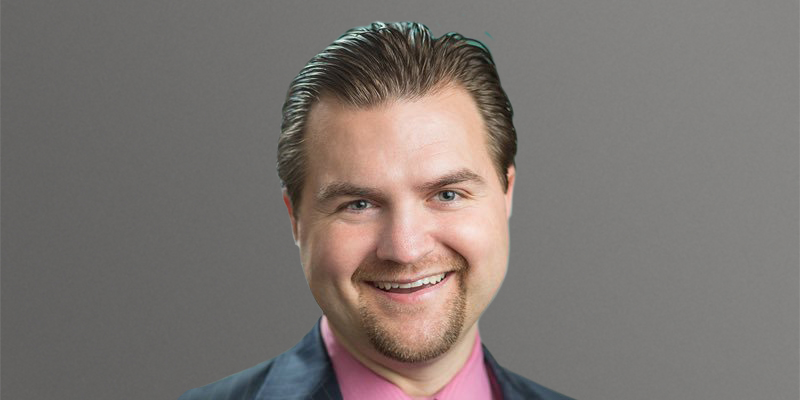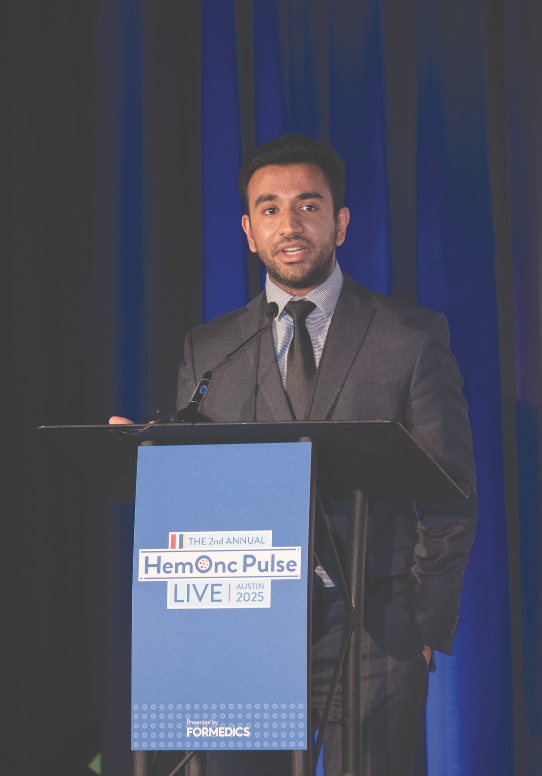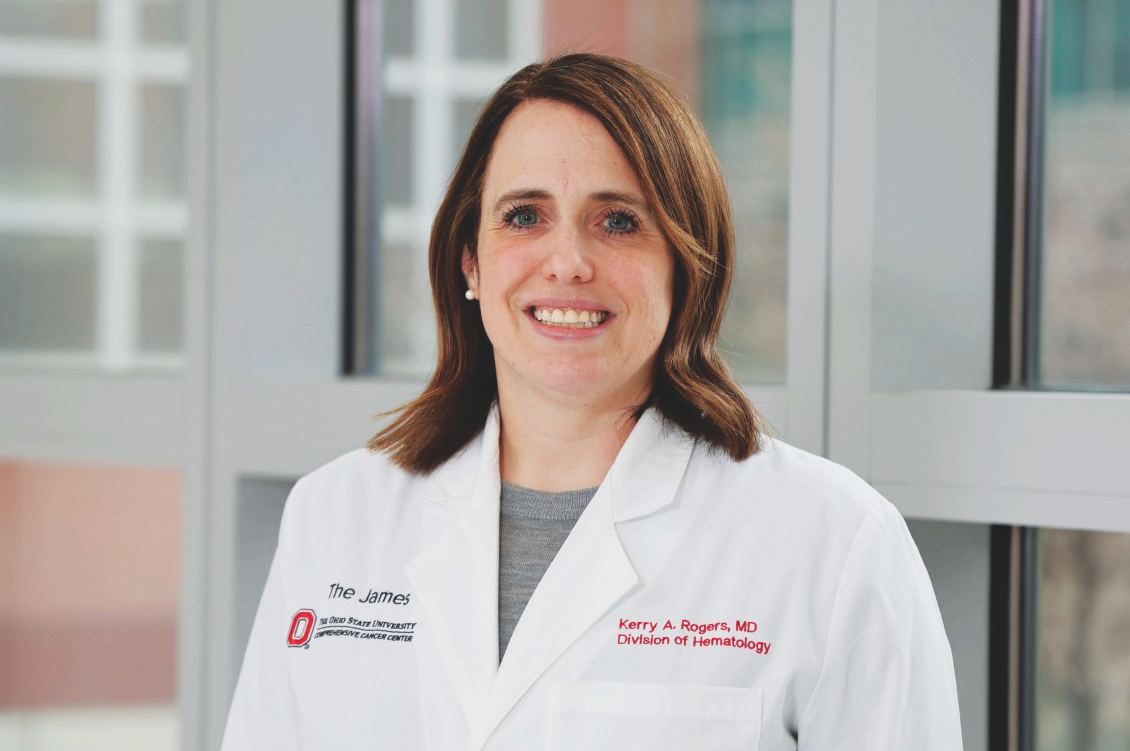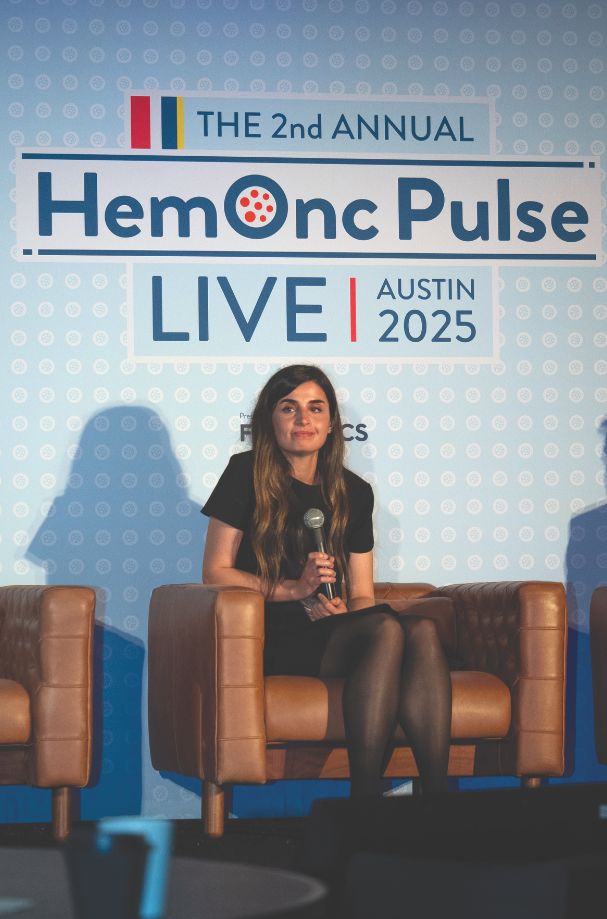
Matthew Lunning, DO, FACP, an Associate Professor in the Division of Hematology/Oncology at the University of Nebraska Medical Center, discusses his origins in clinical research, the rise of cellular therapy, and the parallels between teaching tennis and medicine.
Where did you grow up, and when did you know you wanted to be a physician?
I grew up in Mason City, Iowa, in a middle class family right next to the railroad, so I can sleep through anything. My mom, Marianne, has been an orthopedic nurse for 45 years at the same hospital on the same floor. I admired her loyalty and her willingness to lead when COVID-19 struck our city. I grew up idolizing my mom and spent my summers at our local community hospital playing catch with foam balls with the bedbound, postoperative patients. I’d always have to go and hide when the doctors came to round. I enjoyed the hospital environment growing up as a child.
Fittingly, one of my first jobs introducing me into health care was as a clinical research assistant at my local community cancer center. This role introduced me to the concept of clinical trials, which spurred my interest into oncology in general. Then I met Gerald Marti, MD, PhD, whose father had cancer. He has been very instrumental in my life. He worked at the National Institutes of Health and helped run a clinical flow cytometry lab back in the days when flow cytometry was in its infancy. He offered me a “quick trip” to work in his lab and help write a case report about mantle cell lymphoma. I spent two weeks in his lab from early morning to dark and got an understanding of what it meant to do clinical research and bench research. That two-week experience led to two summers of working in his lab at the Center for Biologic Evaluation and Research.
From that oncology experience in clinical research and further research focused on blood cancers, I knew that I wanted to do blood cancer research before I even matriculated into medical school. I tell people I’ve been a blood cancer researcher since I was 19.
Were there any other mentors who shaped your career path?
There’s been a bunch along the way. Over time, you become a little piece of your mentor. It’s like the ‘antihorcrux,’ to make a Harry Potter reference. You take on the good pieces of those mentors but still have you own core flare.
Peter Silberstein, MD, a community oncologist, gave me first access to patients. He was the first to have one-on-one discussions with me and test my knowledge to see if I could effectively communicate. From those days, I knew at the core of being a physician is being an effective and creative communicator. At a very young age, he gave me those opportunities through the lens of clinical trials, which was often foreign to patients and their family.
Dr. Marti opened my eyes to what it meant to work for the federal government and how the clinical research engine works on the other side from a device or technology standpoint. I got to see both community research and federal research at the age of 19. He also introduced me to writing with a goal to be published in peer-reviewed journals.
I also met James Armitage, MD, through a random phone call at the age of 19 from a clinical trial question. He asked me more about myself than I did about the clinical trial. My mind was blown about who this man was. I researched him endlessly on that new thing called the internet. I aspired to be like him and tried to mold my career path such that I would get to work with him. As a result, I went to the University of Nebraska Medical Center’s internal medicine residency program. During my residency, I got the opportunity to work with him and be a principal investigator on a prospective clinical trial that looked at cardiac magnetic resonance imaging in lymphoma patients, a new technology at the time. It got me exposure to writing clinical trials from scratch, an important feat one should do at least once in their careers. I needed faculty support, and he was willing to be the mentor to put his stamp on—among others—in the institution. He helped low the fence and showed that residents can do prospective clinical research, too.
That experience helped navigate me to a hematology oncology fellowship at the Memorial Sloan Kettering Cancer Center in New York City, which I think is one of the best fellowships in the world. There, I met Steve Horwitz, MD, a T-cell lymphoma expert. He taught me not only how to conduct clinical trials, but how to do it in an efficient team environment where everyone knew the role. He also taught me how to work with industry sponsors through investigator-initiated trials and industry sponsored research. He allowed me to understand not only the interplay between FDA, sponsor, and principal investigators, but also gave me an introduction to understanding the financials of research and how to do it.
When I came back to Nebraska, I returned under Dr. Armitage’s tutelage and the leadership of Julie Vose, MD, MBA. I have grown in my research career, but also through those individuals.
What advice would you give to younger physicians or trainees in the field?
Several people have helped me in my career, so I feel that it’s necessary to pay it forward. I mentor both internally and externally. It’s always important to have internal mentors, but it’s almost as important to have external mentorship to help address different issues that come along the path to becoming a successful academic physician.
One piece of advice is that you have to be careful of saying “yes.” Dr. Vose would harp on me when I had too many things on my academic plate. We all have that fear of missing out. You get an offer to do a review article, write an article, or see more patients. But everybody enters their career in different landscapes. Some enter their career taking over a patient panel for a physician who’s either moving into retirement or moving on to a different institution for a different opportunity. Then, there’s some who enter a career with zero patients and have to build. Understanding the landscape you’re coming into can provide different footing to how you grow. I believe it is incredibly important to walk before you run so you can excel clinically early in your career. If you don’t have that clinical footing and clinical trust with yourself and your team, then you’re always scrambling in the clinic.
This impacts you negatively in other aspects of your career, whether it’s doing clinical research or the ability to sit down and understand clinical research operations. The first six months are getting your clinical footing, and the next six months are understanding your clinical research operations and how clinical trials work at the institution you work at. I came with a general understanding of how clinical trials work, but I wanted to understand how the machinery works, the parts within the machine, and the assembly line of coming up with a clinical trial idea, getting it approved, then reporting it out. I dug in deep and got my hands dirty in the clinical trial operations. I think that not a lot of investigators are educated along the way through residencies and fellowships on the conduct and operations of clinical research. That hamstrings them along their career.
Can you talk about your current clinical research?
One of my areas of major focus is cellular therapy. I consider myself a global ambassador for cellular therapy. I travel around the world talking about access issues to cellular therapy. Access remains one of the major issues to the implementation of the successes of cellular therapy in lymphoma and other hematologic malignancies and as it moves into solid tumor oncology through different mechanisms, whether it’s [chimeric antigen receptor (CAR)] T-cell, bispecific T-cell engagers, tumor-infiltrating lymphocytes, or other forms of immunotherapy. Getting it right, right now, is imperative to future success.
How do we access those technologies for everybody, and not just those who can travel to the centers that have them? That’s where the next revolution comes. Can we find technologies like allogeneic cellular therapies that are off the shelf and have broader applicability that can get more access because the toxicity profile may afford it? Off the shelf nature means that you don’t have to have apheresis capabilities, biological processing facilities, or the chain of command capabilities constraints. We’re learning through clinical trials and asking ourselves the question: “is this portable to a broader environment?”
There’s also an explosion of opportunities happening in autoimmunity, which has become a hot topic within the cellular therapy world. Do you need autologous products? Should you be using autologous products in people with other underlying autoimmune disorders who have historically been excluded from clinical trials in earlier autologous CAR T-cell trials because of the concern for how their immune system inherently behaves versus leveraging that allogeneic aspect where you’re using a single donor source or somebody else’s immune system that’s unperturbed by an underlying autoimmune condition? Can you get the same successes without the potential inherent risks of an autologous product?
Trying to do my part in answering some of those questions, I assisted in shepherding CAR-T into the autoimmune space here at the University of Nebraska. First in rheumatology, then moving into lupus, scleroderma, and myositis—classically uncommon and underserved research arenas that strike individuals within the prime of their lives. We often focus on cancer, but we also need to focus on other conditions like autoimmune conditions that lead to long-term quality of life issues that can be manifested as end-stage renal disease or another end-organ damage that we classically think is part of the natural history. Can we intervene into that natural history with cellular therapy? I think this will spread into other disorders like multiple sclerosis. We’re building an infrastructure that exports my experience and my team’s experience in cellular therapy to onboard those therapies to investigators who have never heard of cellular therapy, CAR T-cell, or natural killer cell research.
We’re doing that through a gene and cellular therapy support service, where a cellular therapist and a cellular therapy research coordinator who have years of experience are supporting other research teams to onboard cellular therapies within their own discipline, whether it’s lupus, multiple sclerosis, or cystic fibrosis. How can cellular therapy potentially impact those diseases in a way where you limit the risk not only to the subject, but to the institution that’s trying to bring this powerful technology to a noncancer population?
When you hear scary words like neurotoxicity or cytokine release syndrome, those are things you want to have experienced individuals involved in the research team to help shepherd those technologies through focused areas and to eager people who want to learn. You want to educate, onboard, gain experience, then allow them to learn within a mentee/mentor role. That’s something I’ve established with one of our rheumatologists, Jennifer Medlin, MD. We recently did the first allogeneic CAR T-cell in lupus in the world, which brought back the butterflies I had when I did my first CAR-T for hematologic malignancies at Nebraska. As a junior investigator, she understands that she has an amazing opportunity to lead this study while being supported in the shadows by a seasoned support team. It’s very fulfilling to do, and I love seeing others succeed as my mentors have seen in me. It’s fun to be there for them and watch them grow in confidence.
What do you hope to see in the field over the next 10 years?
I want to see the continued rise of cellular therapy, and I want to see it become more broadly accessible. Equity of opportunity is very important to me. How do we expand the therapeutic realm to not only bring safe cellular therapy products to those who want them, but to also expand the education on who truly is a CAR T-cell or cellular therapy-eligible patient? We see that in oncology, but we also see that as we move into nononcologic clinical trials.
Sometimes the most ill can’t get access to them, so trying to find the sweet spot of where the risk-benefit is not only in oncology—as we drive forward earlier lines of therapy—but also outside of oncology through clinical trials. Finding cellular therapies that have broader applicability and access can only happen through clinical trials and broader education on the technology.
I travel across the world talking about access to this technology. I talk to people about how they dealt with access issues in different health systems, whether it’s a private health care-based system like the United States, a national health care system like in England or Canada, or a hybrid system like in other Southeast Asian countries. A lot of them are still trying to get access to some of the therapies that we take for granted. They struggle to get rituximab. They want to learn about these key technologies, but they’re still struggling to get certain therapeutics that I wouldn’t blink an eye at thinking of getting. I’ve become humbled by some of the situations I hear about.
What hobbies or activities do you enjoy outside of work?
I really enjoyed teaching tennis to pay for my undergraduate and medical school education. I was given a gift of learning how to communicate and teach effectively through Dr. Steven Wilkinson, my tennis coach at Gustavus Adolphus College. His philosophy of “tennis and life” resonated with me and has stayed at my core. It was his ability to communicate with people one-on-one on something that may frustrate them, give them suggestions, and see them improve and succeed through a different approach. It was very complimentary to a life in medicine.
What would you do for a living if you weren’t a doctor?
When I was trying to get into medical school, I was in Washington, DC, in Bethesda, Maryland, right by the National Naval Medical Center. I was one of those kids who grew up watching Top Gun over and over. If I couldn’t get into medical school, I was going to try to be a naval officer because I’d have my bachelor’s degree and apply to be a pilot. I was short and had the Tom Cruise build. I wanted to fly F-16s with my hair on fire having no piloting experience. I learned that you didn’t need to have piloting experience, you just had to be a naval officer to apply. I finished my flight application for the Navy, but I got into medical school instead. Whenever I go to meetings in San Diego and we stay up in La Jolla, right by Miramar, I hear the F-16s shooting over the hotel. That could have been me!






 © 2025 Mashup Media, LLC, a Formedics Property. All Rights Reserved.
© 2025 Mashup Media, LLC, a Formedics Property. All Rights Reserved.